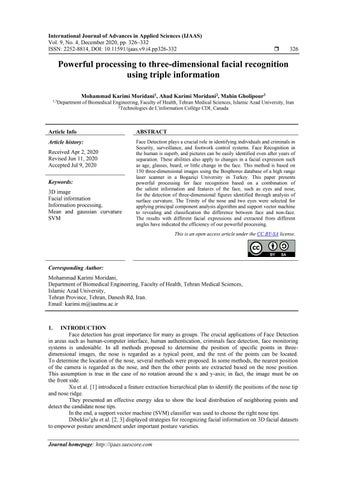International Journal of Advances in Applied Sciences (IJAAS) Vol. 9, No. 4, December 2020, pp. 326~332 ISSN: 2252-8814, DOI: 10.11591/ijaas.v9.i4.pp326-332
326
Powerful processing to three-dimensional facial recognition using triple information Mohammad Karimi Moridani1, Ahad Karimi Moridani2, Mahin Gholipour3 1,3Department
of Biomedical Engineering, Faculty of Health, Tehran Medical Sciences, Islamic Azad University, Iran 2Technologies de L'information Collège CDI, Canada
Article Info
ABSTRACT
Article history:
Face Detection plays a crucial role in identifying individuals and criminals in Security, surveillance, and footwork control systems. Face Recognition in the human is superb, and pictures can be easily identified even after years of separation. These abilities also apply to changes in a facial expression such as age, glasses, beard, or little change in the face. This method is based on 150 three-dimensional images using the Bosphorus database of a high range laser scanner in a Bogaziçi University in Turkey. This paper presents powerful processing for face recognition based on a combination of the salient information and features of the face, such as eyes and nose, for the detection of three-dimensional figures identified through analysis of surface curvature. The Trinity of the nose and two eyes were selected for applying principal component analysis algorithm and support vector machine to revealing and classification the difference between face and non-face. The results with different facial expressions and extracted from different angles have indicated the efficiency of our powerful processing.
Received Apr 2, 2020 Revised Jun 11, 2020 Accepted Jul 9, 2020 Keywords: 3D image Facial information Information processing, Mean and gaussian curvature SVM
This is an open access article under the CC BY-SA license.
Corresponding Author: Mohammad Karimi Moridani, Department of Biomedical Engineering, Faculty of Health, Tehran Medical Sciences, Islamic Azad University, Tehran Province, Tehran, Danesh Rd, Iran. Email: karimi.m@iautmu.ac.ir
1.
INTRODUCTION Face detection has great importance for many as groups. The crucial applications of Face Detection in areas such as human-computer interface, human authentication, criminals face detection, face monitoring systems is undeniable. In all methods proposed to determine the position of specific points in threedimensional images, the nose is regarded as a typical point, and the rest of the points can be located. To determine the location of the nose, several methods were proposed. In some methods, the nearest position of the camera is regarded as the nose, and then the other points are extracted based on the nose position. This assumption is true in the case of no rotation around the x and y-axis; in fact, the image must be on the front side. Xu et al. [1] introduced a feature extraction hierarchical plan to identify the positions of the nose tip and nose ridge. They presented an effective energy idea to show the local distribution of neighboring points and detect the candidate nose tips. In the end, a support vector machine (SVM) classifier was used to choose the right nose tips. Dibeklio˘glu et al. [2, 3] displayed strategies for recognizing facial information on 3D facial datasets to empower posture amendment under important posture varieties. Journal homepage: http://ijaas.iaescore.com
